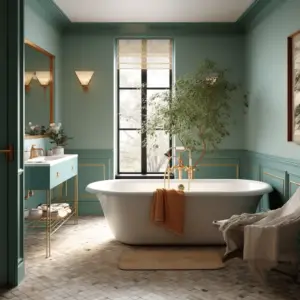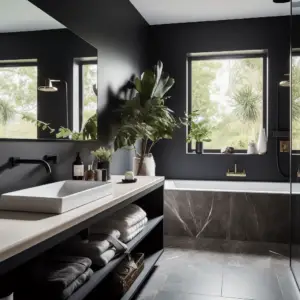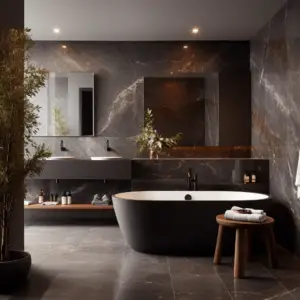Today, bathrooms are an integral part of our lives. Not only a place to freshen up, they are also havens of relaxation and renewal. Renovating a bathroom can be an exciting, transformative experience. It’s a chance to customize the area to your own taste. Whether you want to improve its functionality, update its looks, or make it more inviting, this article provides tips and creative ideas.
Start by considering your needs, and deciding the scope of the project. Do you need a complete renovation, or just small changes? Will the layout or plumbing stay the same? Setting goals helps make the process easier.
Next, make a realistic budget. Consider not only materials and labor costs, but also any hidden costs like permits or structural changes. Research different suppliers to find the best prices without sacrificing quality.
Fixtures and materials should be chosen for both their looks and their functional benefits. Choose materials that hold up to moisture and frequent use, and that also enhance the atmosphere. Look for inspiration in design magazines and online for unique ideas that suit you.
Finally, make sure to hire experienced professionals for the job. Their knowledge will ensure that the project goes well. Keep in touch with them throughout the process to clearly convey your vision and check on progress.
As Frank Lloyd Wright said, “The space within becomes the reality of the building.” With careful planning and attention to detail, you can create a bathroom that reflects your style and makes life more enjoyable. So, get ready to renovate your bathroom – a project that adds value to your home and fulfillment to your life.
Table of Contents
Planning and Preparation

Renovating a bathroom? Here are 3 must-knows:
- Research – Figure out the look, materials and budget for your project. This helps you make smart choices.
- Measurements – Take exact measurements of your bathroom to have an effective layout and not waste money on mistakes!
- Timeline – Plan a realistic timeline with milestones for tasks like demolition, plumbing and electrical work.
Plus, each bathroom renovation is unique. You may need to adjust your design due to plumbing position or other factors.
Pro Tip: Talk to a pro designer or contractor for guidance and get the most out of your bathroom renovation!
Hiring Professionals or DIY
When it comes to revamping a bathroom, one query is: hire pros or do it yourself? Each option has its pros and cons.
- Cost: Hiring experts may cost more at first, but they have the experience and tools to finish the job quickly. DIY may seem economical, but mistakes can lead to higher expenses.
- Time: Pros can finish renovations faster due to their proficiency. DIY projects may take longer, particularly if you lack prior experience with bathroom renovations.
- Skills: Experts possess specialized skills that guarantee a top-notch result. As a beginner, you may not have the same level of expertise and could end up with below par outcomes.
- Frustration: Doing a bathroom renovation project yourself can be overwhelming and demanding. Professionals take away the burden by handling all the details for you.
- Customization: Hiring pros enables you to collaborate on design ideas and make a personalized bathroom space. DIY projects limit your options and could not achieve the same level of customization.
- Risks: Incorrect installation or repairs in bathrooms can cause water damage or safety hazards. Professionals know how to stick to building codes and minimize potential risks.
When deciding between hiring professionals or going the DIY approach for your bathroom renovation project, it’s worth thinking about other factors. Assessing your own abilities, available time, and budget will help guide your decision-making process.
Did you know? A survey conducted by HomeAdvisor found that around 74% of homeowners in the United States hire professionals for bathroom renovations instead of trying it themselves.
Design and Layout
Design and layout are key for a bathroom remodel. A great design maximizes comfort and function, and makes the space look even better! Here are some things to consider:
| Aspect | Considerations |
|---|---|
| Plumbing | Connect plumbing for efficient water flow. |
| Lighting | Install fixtures for a well-lit ambiance. |
| Storage | Use cabinets, shelves, or vanity units. |
| Ventilation | Put in a ventilation system to avoid excess moisture. |
| Flooring | Choose durable and waterproof materials. |
| Color Scheme | Pick colors that match the aesthetic. |
| Fixture Placement | Position fixtures to maximize space. |
| Accessibility Features | Use grab bars or curbless showers for easy access. |
Remember to use materials that resist water damage and are easy to maintain. Plus, pick fixtures and accessories to match the style.
In Victorian England, bathrooms were luxurious additions to the wealthy. They often had elaborate designs, intricate tiling, and opulent fixtures. Now, bathrooms are essential spaces in every home that blend function and aesthetics. Design trends focus on sleek, minimalistic spaces for relaxation.
Demolition and Removal
The Demolition and Removal phase is key in bathroom renovations. Take a look at these tasks:
- Remove fixtures: Disconnect, detach, and get rid of bathroom fixtures.
- Take out old tiles: Carefully take off tiles from walls and floors without causing harm.
- Tear out cabinets: Take apart and move out cabinets to make way for new storage.
- Dispose of debris: Safely get rid of demolished materials to stay clean.
- Address plumbing: Look over plumbing connections and do necessary changes.
- Evaluate electrical: Check electrical setup for any updates or modifications.
Safety is important during this process. Wear protective gear like gloves, goggles, masks, and strong shoes to avoid injury from sharp objects or debris.
Don’t miss out on making your dream bathroom—start demolishing now! Be careful in this initial step to create a successful transformation with style, practicality, and relaxation in your new space.
Plumbing and Electrical Work
It’s important to pay attention to the electricity and water parts when remodeling a bathroom. People who work in plumbing, among other things, put in new lines, fix leaks, change faucets, and connect shower fixtures. As part of the electrical work, light fixtures are wired, vent fans are installed, GFCI plugs are added, and hot towel racks are put up.
When working with plumbing and electricity, it’s important to remember how to seal and ground. This keeps people safe and keeps wetness from damaging electrical parts.
Plumbing has been around since the time of Rome and Egypt. They used aqueducts and lead pipes to get water to their cities. In the same way, improvements in electricity go back hundreds of years, from Benjamin Franklin’s lightning rods to Thomas Edison’s electric light bulb.
To successfully remodel a bathroom, you need to know how important plumbing and electricity work are. Mixing modern and old ways of doing things helps make a bathroom that works well and looks good.
Flooring and Wall Installation
Tiles are great for bathroom flooring; they’re water-resistant, easy to clean, and come in a range of colors, patterns, and textures.
Walls should be made of waterproof materials like cement boards or moisture-resistant drywall. Insulation helps maintain a cozy temperature.
Before installation, make sure to clean surfaces, remove debris and old adhesive, and level the floor. Consult a professional contractor for expert advice that fits your needs and preferences.
Installation of Fixtures and Accessories

Installing fixtures and accessories in a bathroom takes careful organizing and execution. Here’s a guide to help you through the process:
- Choose features and extras that match your style. This could include taps, showerheads, towel bars, toilet paper holders, and soap dispensers.
- Get skilled plumbing work done before installing. To avoid leaks or other problems during installation or afterward.
- Follow the directions that came with each fixture and accessory to start the installation. Use the right tools and materials to connect them to the right places in the bathroom.
- After the fittings and items are set up, make sure they work right. Test them by running water through the taps to see if they drip or leak. Make any changes that are needed.
Extra details for installing fixtures and accessories in the bathroom:
- Consider the placement of each item to get the most out of the space.
- Look at finishes to create a unified look in the room.
- Ventilate the bathroom properly to stop moisture-related issues.
Pro Tip: It’s always a good idea to chat with a professional contractor or interior designer before beginning your renovation project. They can offer expert advice and hints.
With proper planning and execution for the fixtures and accessories in your bathroom renovation project, you’re a step closer to your dream bathroom.
Finishing Touches
Renovating your bathroom? Focus on the finishing touches! Paint color, fancy fixtures – these details give the space character and style.
Tiles are important. Pick ones that are stunning, durable, and easy to clean. Patterns, textures, and colors should fit your theme.
Lighting is key too. Task lighting near the vanity. Ambient lighting for cozy baths.
Don’t forget the little things – mirrors, artwork, plants – that reflect your style.
Did you know ancient Egyptians loved exquisite bathrooms? Gold mosaic tiles, intricate carvings. They understood the value of those finishing touches.
Don’t underestimate the power of finishing touches! They can turn an ordinary space into an oasis. Take your time selecting each one – for a truly remarkable bathroom renovation.
Final Inspections and Cleaning

Once upon a time, in a grand old mansion, there was a bathroom renovation project. The contractor made a huge mistake – they forgot to do the final inspections and cleaning! This led to problems, such as leaky faucets, faulty electrical connections, and mold growth. It caused delays and frustration for all involved.
Ever since then, the importance of inspections and cleaning has been taken seriously. Here’s a step-by-step guide for completing these crucial tasks:
- Inspect every corner. Check fixtures, tiles, plumbing connections, electrical fittings, and ventilation systems. Look for any signs of damage or issues.
- Clean with precision. Remove dust, dirt, and grime from surfaces. Make sure to clean hard-to-reach places, like behind toilets and under sinks.
- Final checks. Test all fixtures to ensure they’re working correctly. Look for leaks or drips and fix them quickly.
Remember – the final inspections and cleaning are essential for a successful bathroom renovation. It may be a small step, but it’s important for making the bathroom safe, functional, and beautiful!
Conclusion
Time to transform your old bathroom! Renovating requires planning, attention to detail, and a bit of creativity. Follow these steps for a modern oasis.
- Assess the space. Identify repairs or upgrades, like fixing leaks, replacing old fixtures, or updating lighting.
- Consider design elements that reflect your personal style. Choose a color scheme, select tile patterns, or install statement pieces like a vanity or bathtub.
- Functionality is key. Maximize storage with shelves or cabinets. Install energy-efficient fixtures to save water and electricity.
- Tackling a bathroom renovation can be tough. Stay organized and take it one step at a time. Professional help is an option.
Pro Tip: Create a budget and timeline to stay on track. This will prevent unexpected expenses and delays.
With these tips, you’ll have an inviting space that suits your practical needs and aesthetic preferences. Start planning your bathroom renovation today!
Frequently Asked Questions
FAQ 1:
Q: What is the first step in renovating a bathroom?
A: The first step in renovating a bathroom is to plan and design the layout. Consider factors such as the available space, plumbing needs, and your desired style before proceeding.
FAQ 2:
Q: Can I renovate a bathroom on a budget?
A: Yes, it is possible to redo a bathroom on a tight budget. You can focus on making important changes, such as updating fixtures, painting or redoing surfaces, and choosing inexpensive materials. Putting your wants in order of how important they are will help you keep your remodeling costs low.
FAQ 3:
Q: Do I need a professional contractor for a bathroom renovation?
A: You can do a bathroom renovation yourself, but it’s best to hire a professional, especially for complicated jobs that involve plumbing and electricity. A contractor has the skills, knowledge, and licenses needed to make sure a renovation is done safely and well.
FAQ 4:
Q: What are some popular bathroom design trends?
A: Open showers, freestanding tubs, minimalist styles, natural materials like stone or wood, and smart bathroom technology are some current bathroom design trends. But it’s important to choose a pattern that fits your personal tastes and goes with the rest of your home’s style.
FAQ 5:
Q: How long does a bathroom renovation usually take?
A: The length of a bathroom renovation relies on how much work needs to be done and if any problems come up that were not planned for. In general, an easy renovation can take a few weeks, while a bigger one could take a few months. When planning the repair, it’s important to think about how long it will take.
FAQ 6:
Q: Is it necessary to obtain permits for a bathroom renovation?
A: Permits may be needed for some parts of a bathroom remodel, like when the structure is changed or when electrical or plumbing work is done. Check with your local government or talk to a worker to find out what permits you need to make sure you’re following building codes and rules.